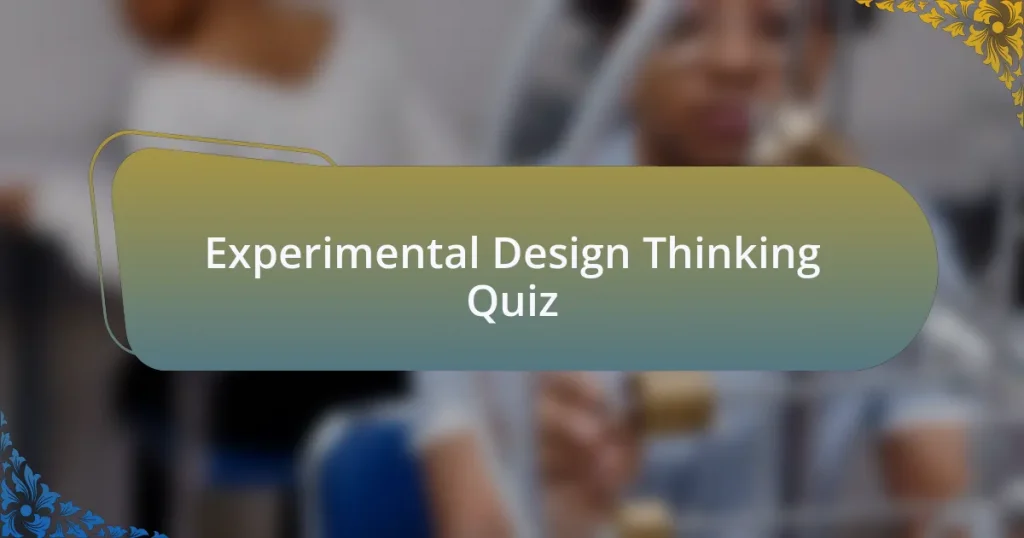Start of Experimental Design Thinking Quiz
1. What is the primary goal of applying Design Thinking in physics test preparation?
- To focus solely on theoretical understanding of physics
- To foster creativity in problem-solving for physics concepts
- To create standardized tests for student assessment
- To simplify physics equations for students
2. How many stages are involved in the Design Thinking process relevant to physics education?
- 4
- 5
- 7
- 3
3. Which stage focuses on understanding students` learning needs in physics?
- Designing Curriculum
- Evaluating Performance
- Assessing Learning Needs
- Testing Understanding
4. What creative technique can be used to generate ideas for improving physics test preparation?
- Memorization
- Brainstorming
- Lecture Notes
- Group Reading
5. What does prototyping entail when designing physics test study materials?
- Developing a detailed project plan for execution
- Establishing a marketing strategy for the finished material
- Creating a simplified version of the product to test potential solutions
- Conducting a final evaluation of the completed product
6. In the context of physics education, why is the `Empathize` stage vital?
- To implement the final solution
- To understand the needs and emotions of users
- To develop technical specifications for the design
- To evaluate the effectiveness of prototypes
7. What is a key characteristic that distinguishes Design Thinking from other problem-solving approaches in physics?
- Focus on individual creativity over collaboration
- Emphasis solely on technology solutions
- A human-centered approach prioritizing user needs
- A strict linear process with fixed outcomes
8. During which Design Thinking phase do educators define the challenges students face in learning physics?
- Ideate
- Define
- Empathize
- Test
9. What role do user personas play when designing physics test preparation strategies?
- To simplify physics concepts into absolute rules for everyone.
- To establish guidelines that limit student creativity in studies.
- To create detailed representations of students` learning needs in test prep.
- To create generic study materials without user input.
10. What core design principle should educators focus on when preparing physics tests?
- Aligning questions with learning objectives
- Using complicated terminology
- Designing tests with no real-world application
- Focusing solely on memorization
11. What aspects of prototypes should be evaluated during the `Test` stage in physics learning material?
- The environmental impact of the prototype
- The historical significance of the prototype
- The usability of the prototype
- The aesthetic appeal of the prototype
12. Which trait is essential for educators engaging in Design Thinking for teaching physics?
- Bias towards action
- Focus on technology only
- Avoiding user input
- Strict adherence to rules
13. In which stage are solutions for physics test preparation developed and executed?
- Implementation
- Assessment
- Observation
- Evaluation
14. Who are the essential stakeholders in a Design Thinking process for physics education?
- Just the design team
- Only educators and students
- Only academic institutions
- All stakeholders, including end-users and clients
15. Why is the `Fail Fast` approach beneficial when testing physics teaching methods?
- It encourages students to memorize facts without understanding.
- It focuses solely on standardized testing outcomes.
- It allows for quick evaluations of teaching effectiveness and adjustments.
- It promotes a rigid teaching style that avoids risk.
16. What is the purpose of creating a journey map in physics curriculum design?
- To visualize the user experience and interactions over time
- To simplify complex equations in physics
- To measure the physical properties of matter
- To create a timeline of historical discoveries
17. Why is empathy considered a crucial element in developing physics test strategies?
- Empathy helps tailor study methods to diverse learning styles.
- Empathy primarily enhances memory retention techniques.
- Empathy increases focus on solving equations only.
- Empathy reduces collaboration among study groups.
18. What does a human-centered approach imply for physics test preparation?
- The preparation process ignores student feedback and learning preferences.
- The preparation process prioritizes standardized testing over student engagement.
- The preparation process is entirely based on memorizing formulas and theories.
- The preparation process focuses on understanding students` individual needs and learning styles.
19. What is the ideation phase`s significance in creating effective physics assessments?
- It helps generate a variety of ideas for assessment design.
- It serves to finalize assessments without input from others.
- It limits creativity and restricts options for questions.
- It focuses only on theoretical concepts without practical applications.
20. How does prototyping improve the development of physics study guides?
- It permanently finalizes the study guide content.
- It allows for iterative testing and refinement.
- It reduces the number of topics in the study guide.
- It simplifies the physics concepts for easier learning.
21. What is the comprehensive description of the Design Thinking process in the context of physics education?
- It follows a strict linear pathway for problem-solving without user input.
- It emphasizes technical solutions over understanding user needs.
- It is a one-time procedure focused solely on identifying problems.
- It is a human-centered, iterative process consisting of five stages: empathize, define, ideate, prototype, and test.
22. What is the inaugural stage when utilizing Design Thinking for physics curriculum development?
- Prototype
- Empathize
- Ideate
- Define
23. What follows the `Empathize` stage in the physics educational Design Thinking process?
- Prototype
- Test
- Ideate
- Define
24. What is the third phase when addressing issues in physics test design?
- Prototype
- Define
- Test
- Ideate
25. Can you list the five essential skills needed for successful Design Thinking in physics education?
- Technical writing, analysis, report generation, coding skills, and observation
- Emotional intelligence, consensus building, user research, journey mapping, and brainstorming
- Memorization, critical thinking, data analysis, presentation skills, and note-taking
- Linear thinking, problem identification, observational skills, intuition, and mapping
26. How is Design Thinking defined within the realm of physics problem-solving?
- A strictly linear process without feedback.
- A phase that prioritizes cost over creativity.
- A method only for technical designers.
- A problem-solving approach focused on user needs.
27. What foundational principles underpin the Design Thinking approach to physics teaching?
- Prioritizing financial constraints over user needs
- The human rule, the ambiguity rule, all design is redesigned, and the tangibility rule
- A strictly linear approach to problem-solving
- Focusing exclusively on technical specifications
28. Why is empathy regarded as fundamental in developing effective physics assessments?
- Empathy complicates the grading process for teachers.
- Empathy has no relevance in the assessment structure.
- Empathy disrupts standard testing protocols excessively.
- Empathy helps tailor assessments to diverse learning needs.
29. What involves consolidating insights from the `Empathize` stage for physics tests?
- Testing prototypes
- Compiling observations from the empathize stage
- Brainstorming ideas
- Defining the solution
30. What does prototyping entail specifically in the context of physics test preparation?
- Conducting extensive experiments without analyzing user feedback.
- Memorizing all relevant equations without practical application.
- Writing a complete report on theoretical principles and formulas.
- Creating a simplified version of a concept to explore and test solutions.
Congratulations on Completing the Quiz!
You’ve successfully completed the quiz on Experimental Design Thinking. This process is crucial for blending creativity with rigorous scientific method in physics. Throughout the quiz, you may have explored principles that influence how experiments are structured. Understanding these principles can enhance your ability to design effective experiments in your physics studies.
This quiz offered insights into essential components of experimental design. You likely learned about variables, controls, and how to formulate hypotheses. These concepts are foundational in physics, where experiments test theories and expand knowledge. Applying these principles will help you approach problems systematically and critically.
To further enrich your understanding, we invite you to check out the next section on this page. It contains valuable information specifically focused on Experimental Design Thinking. This resource will deepen your knowledge and prepare you for advanced concepts in physics. Engaging with this material will undoubtedly benefit your test preparation and enhance your studies. Happy learning!
Experimental Design Thinking
Introduction to Experimental Design Thinking
Experimental design thinking involves a structured approach to problem-solving that embraces hypothesis formulation, experimentation, and analysis. This method prioritizes understanding variables and their interactions. In the context of physics test preparation, this approach enables students to systematically explore physical concepts and principles. By designing and conducting experiments, students can observe outcomes, leading to a deeper understanding of the subject matter.
The Role of Hypothesis Formulation in Physics Test Preparation
Hypothesis formulation is a critical component of experimental design thinking. In preparing for physics tests, students must develop possible explanations for observed phenomena. This encourages analytical thinking and fosters a scientific mindset. By proposing hypotheses, students engage with content and prepare for practical applications of physics concepts, enhancing retention and comprehension.
Implementing Experiments in Physics Education
Implementing experiments allows students to apply theoretical knowledge in a practical setting. In a physics test preparation context, experiments can range from simple demonstrations to complex laboratory setups. This hands-on experience reinforces learning and helps students visualize concepts like Newton’s laws, energy conservation, and wave behavior. Engaging in experimentation solidifies understanding through real-world applications.
Analyzing Results: Data Interpretation in Physics
Data interpretation is essential in evaluating experimental outcomes. In the sphere of physics education, students must learn to analyze data critically. This involves recognizing patterns, determining statistical significance, and drawing conclusions based on evidence. These skills are paramount for success on physics tests, where problem-solving and analytical thinking are key components of assessment.
Adapting Experimental Design for Test Preparation Strategies
Adapting experimental design strategies can enhance physics test preparation. Students may customize experiments based on their learning styles and areas of difficulty. This individualized approach fosters deeper engagement with the material. By tailoring experiments, students can focus on specific concepts and refine their understanding, ultimately leading to better performance on assessments.
What is Experimental Design Thinking in the context of Physics Test Preparation?
Experimental Design Thinking is a methodical approach used in Physics Test Preparation to create structured experiments or activities that help students understand complex concepts. This approach emphasizes iterative processes where students formulate hypotheses, conduct experiments, analyze data, and draw conclusions. For example, when preparing for physics exams, students might design experiments to test principles like Newton’s laws or conservation of energy. This method is often validated by educational research, which shows that hands-on experimentation enhances retention of physics concepts.
How does Experimental Design Thinking apply to Physics Test Preparation?
Experimental Design Thinking applies to Physics Test Preparation by encouraging students to engage in problem-solving through empirical methods. Students are taught to identify variables, control conditions, and analyze results systematically. This approach allows them to apply theoretical knowledge in practical scenarios, leading to deeper understanding. Research indicates that students who engage with concepts through experimental design score higher on tests, as they can relate principles to real-world phenomena, enhancing critical thinking skills.
Where can students find resources for Experimental Design Thinking in Physics Test Preparation?
Students can find resources for Experimental Design Thinking in Physics Test Preparation through educational websites, online courses, and textbooks focused on physics education. Institutions such as universities often provide materials and laboratory kits designed for creating experiments. Additionally, platforms like Khan Academy and Coursera offer specialized courses that include experimental design components. These resources typically emphasize inquiry-based learning, which is crucial for mastering physics concepts.
When should students implement Experimental Design Thinking during their Physics Test Preparation?
Students should implement Experimental Design Thinking during their Physics Test Preparation as early as possible, ideally at the beginning of their study schedule. This allows for the exploration of concepts through experiments and reinforces learning. Regular practice and iterative experimentation should occur throughout the study period, particularly before major exams. Studies show that consistent engagement with experimental activities leads to better retention of knowledge, making it essential to start early.
Who benefits from using Experimental Design Thinking in Physics Test Preparation?
High school and college students preparing for physics exams benefit from using Experimental Design Thinking. This approach caters to diverse learning styles by fostering hands-on experiences. Teachers also benefit, as they can use this method to facilitate more interactive and engaging lessons. Educational research indicates that students who participate in designed experiments demonstrate improved problem-solving skills and a greater ability to synthesize information, ultimately enhancing their academic performance.















